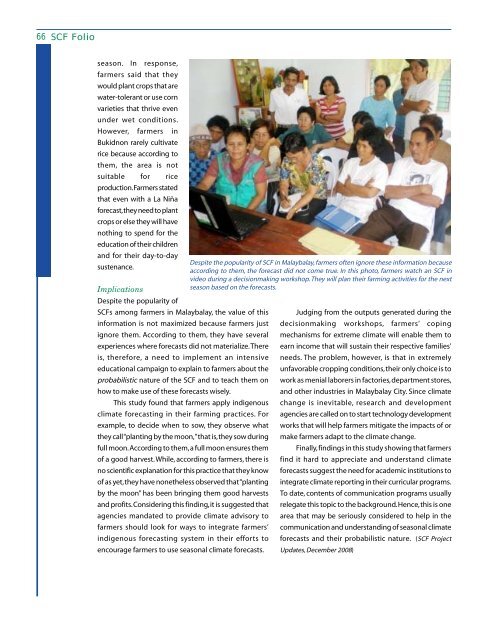Read More - Philippine Institute for Development Studies
Read More - Philippine Institute for Development Studies
Read More - Philippine Institute for Development Studies
Create successful ePaper yourself
Turn your PDF publications into a flip-book with our unique Google optimized e-Paper software.
66 SCF Folio<br />
season. In response,<br />
farmers said that they<br />
would plant crops that are<br />
water-tolerant or use corn<br />
varieties that thrive even<br />
under wet conditions.<br />
However, farmers in<br />
Bukidnon rarely cultivate<br />
rice because according to<br />
them, the area is not<br />
suitable <strong>for</strong> rice<br />
production. Farmers stated<br />
that even with a La Niña<br />
<strong>for</strong>ecast, they need to plant<br />
crops or else they will have<br />
nothing to spend <strong>for</strong> the<br />
education of their children<br />
and <strong>for</strong> their day-to-day<br />
sustenance.<br />
Implications<br />
Despite the popularity of<br />
SCFs among farmers in Malaybalay, the value of this<br />
in<strong>for</strong>mation is not maximized because farmers just<br />
ignore them. According to them, they have several<br />
experiences where <strong>for</strong>ecasts did not materialize. There<br />
is, there<strong>for</strong>e, a need to implement an intensive<br />
educational campaign to explain to farmers about the<br />
probabilistic nature of the SCF and to teach them on<br />
how to make use of these <strong>for</strong>ecasts wisely.<br />
This study found that farmers apply indigenous<br />
climate <strong>for</strong>ecasting in their farming practices. For<br />
example, to decide when to sow, they observe what<br />
they call “planting by the moon,” that is, they sow during<br />
full moon. According to them, a full moon ensures them<br />
of a good harvest. While, according to farmers, there is<br />
no scientific explanation <strong>for</strong> this practice that they know<br />
of as yet, they have nonetheless observed that “planting<br />
by the moon” has been bringing them good harvests<br />
and profits. Considering this finding, it is suggested that<br />
agencies mandated to provide climate advisory to<br />
farmers should look <strong>for</strong> ways to integrate farmers’<br />
indigenous <strong>for</strong>ecasting system in their ef<strong>for</strong>ts to<br />
encourage farmers to use seasonal climate <strong>for</strong>ecasts.<br />
Despite the popularity of SCF in Malaybalay, farmers often ignore these in<strong>for</strong>mation because<br />
according to them, the <strong>for</strong>ecast did not come true. In this photo, farmers watch an SCF in<br />
video during a decisionmaking workshop. They will plan their farming activities <strong>for</strong> the next<br />
season based on the <strong>for</strong>ecasts.<br />
Judging from the outputs generated during the<br />
decisionmaking workshops, farmers’ coping<br />
mechanisms <strong>for</strong> extreme climate will enable them to<br />
earn income that will sustain their respective families’<br />
needs. The problem, however, is that in extremely<br />
unfavorable cropping conditions, their only choice is to<br />
work as menial laborers in factories, department stores,<br />
and other industries in Malaybalay City. Since climate<br />
change is inevitable, research and development<br />
agencies are called on to start technology development<br />
works that will help farmers mitigate the impacts of or<br />
make farmers adapt to the climate change.<br />
Finally, findings in this study showing that farmers<br />
find it hard to appreciate and understand climate<br />
<strong>for</strong>ecasts suggest the need <strong>for</strong> academic institutions to<br />
integrate climate reporting in their curricular programs.<br />
To date, contents of communication programs usually<br />
relegate this topic to the background. Hence, this is one<br />
area that may be seriously considered to help in the<br />
communication and understanding of seasonal climate<br />
<strong>for</strong>ecasts and their probabilistic nature. (SCF Project<br />
Updates, December 2008)










